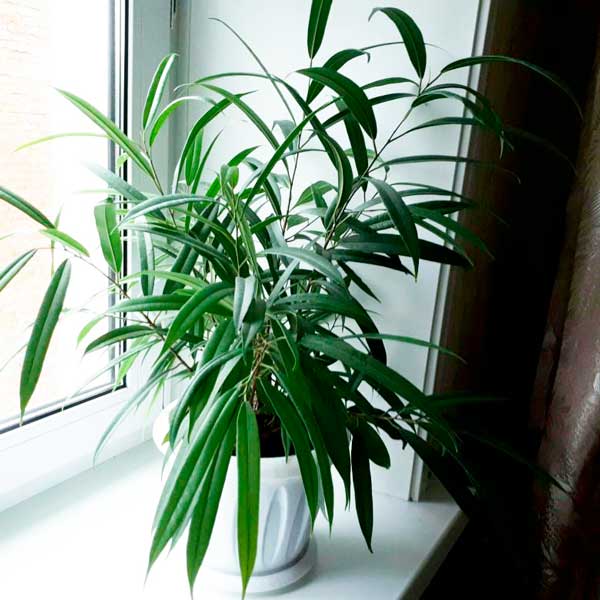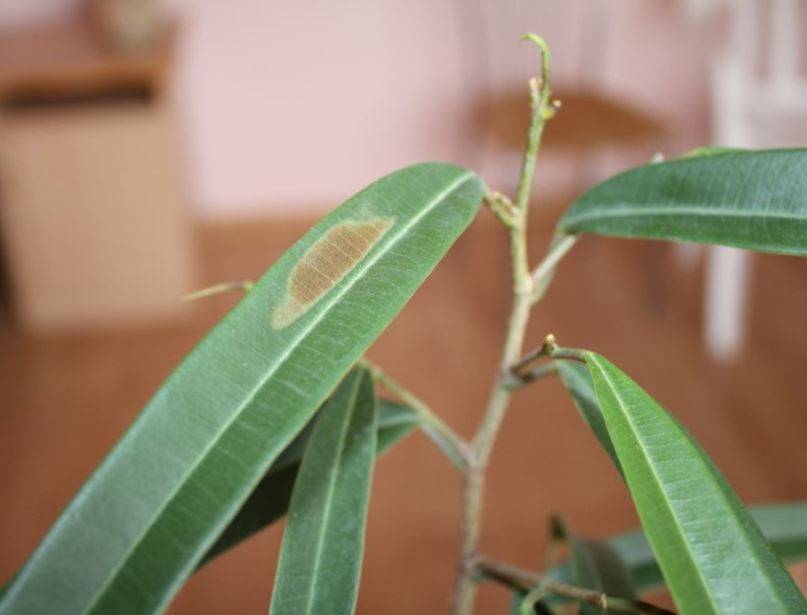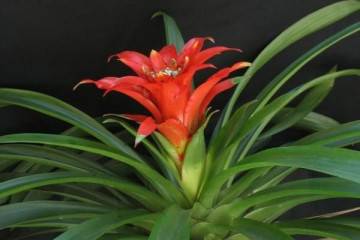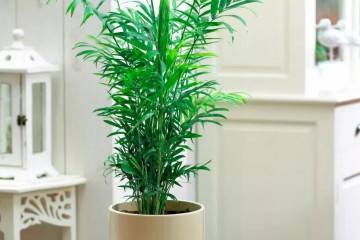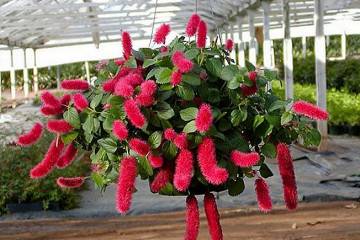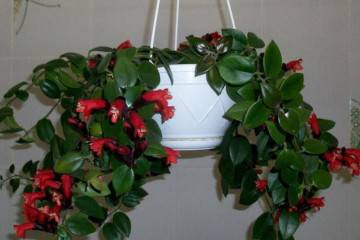Ficus Ali flower - home care
Content:
A tall plant with a luxurious holly crown will decorate a flower corner, combined with any interior style. At first glance, only an experienced florist recognizes Benedict Ali's ficus in him, since he is not much different from other varieties of his family. This plant looks amazing in the interior and is unpretentious in care, if you follow simple rules.
What does the ficus Binnedika Ali look like?
Ficus Ali is often called willow, hinting at the elongated shape of its leaves. However, this term is of folk, not botanical origin. Its family includes several species that differ slightly in color and leaf shape.
Common varieties
Ficus Binnendijka (yes, it is also called that) belongs to the Mulberry family, is an evergreen tree or shrub. In the wild, the plant height reaches 15-20 m, in indoor conditions - up to 1.5 m. The leaves are shiny, have a rich green color. In length they reach 25 cm, in width - 7 cm. At the top, young shoots are slightly twisted, stipules are light green in color. Fully formed leaves are slightly concave towards the middle, paler on the back.
There are four types of Binnendijk ficus:
- Ali (Ali) ". It has wide leaves and is otherwise indistinguishable from other varieties. It is often used in landscaping apartments;
- Amstel King and Amstel Queen. It is difficult to distinguish even for professionals, in the first the width of the leaves reaches 7 cm, in the second the plate is slightly narrower;
- Amstel Gold. It owes its name to its yellow-green color, a gradient that goes from dark to light shades.
Briefly about the history of appearance
Ficus Ali is widespread in the tropics, the length of its growth stretched from Southeast Asia to Vietnam, through the Himalayas, Thailand and Sumatra. In the USA it is grown as an ornamental plant in parks and gardens. Ficus grows in rocky, open areas except in areas that are too dry or humid.
In the wild, it blooms every spring, has male and female buds. It is impossible to achieve flowering of indoor plants, since there is not enough natural pollination by insects.
Features of caring for a flower at home
Despite its exotic origin, Ali's ficus is unpretentious in care. It is relatively easy to create suitable conditions for it, considering the factors of its natural environment.
Temperature
Caring for Ali ficus at home requires compliance with the temperature regime: in the summer period 22-25 ° С, in winter - not lower than 16 ° С. A sharp cooling of the air negatively affects the condition of the leaves. If the soil cools, the rhizomes may also suffer.
Ficus does not like stagnant air, the room with it needs to be regularly ventilated. You need to place the flower away from drafts and heat sources: batteries and heaters.
Lighting
The light-loving ficus Ali pleases with a lush crown in response to good lighting. Moreover, the need for it increases with increasing temperature - this mechanism operates in the tropics.A flower with monochromatic leaves needs partial shade, and with variegated - diffused light. It is recommended to choose a sill from the southeast.
Watering
In summer, water should be watered as the topsoil dries up 1.5-2 cm thick. Water should not be allowed to accumulate in the pan, this can lead to rotting of the root system. In winter, when the growth of ficus slows down, you need to water even less often, until the soil is completely dry. Benedict Ali is able to endure drought, but not excess moisture.
Humidity
As noted above, Ali's ficus does not tolerate waterlogging, the soil should dry out between waterings 3-5 cm deep. In summer, the frequency of watering is 2-3 times a week, in winter - 1 time. The water must be settled, it is poured in small portions in several approaches. After 30-40 minutes. after watering, you need to remove the excess from the pallet.
Priming
Special soil for ficuses can be purchased at a flower shop, and this option is the most reliable. If this is not possible, you should try to do it yourself. This will require:
- turf;
- fine sand;
- brick chips;
- peat.
You need to mix the ingredients in equal parts and pour into the pot. Also, drainage holes need to be made in it.
Top dressing
Top dressing is carried out during the period of active growth: from April to August, once every 2 weeks. You need to use mineral and organic fertilizers, diluting them in water.
Pruning
Ficus Ali, with good care, grows both upward and outward, taking on a slightly sloppy appearance. Pruning will help create a nice shape and also strengthen the tree. It can be carried out only at the beginning of spring; the apical buds should be removed. White juice will stand out from the cut site, which must be blotted with a sponge until it disappears completely. Then you need to fill the "wound" with crushed charcoal (activated or wood).
If you plan to grow Benjamin Ali's ficus tall and spreading, you need to plant 2-3 shoots in a large pot. Their trunks can be intertwined, creating a real living room decoration. The weave should not be too tight without hindrance to growth. Lateral shoots should be pruned as they grow.
How ficus Ali reproduces
Reproduction of ficus Benedict occurs by cuttings, they show good results when rooting. This requires good lighting and suitable twigs. The length of the cutting should be 15-25 cm, cut specimens should be placed in a jar of water. After 2-2.5 months, roots are formed. This method is much faster than greenhouse.
Transfer
Under favorable conditions, the root of the ficus grows rapidly, a flower transplant may be required. For this, the pot should be selected a little larger than the previous one. Part of the new earth is poured into it, the rest of the soil is taken from the old pot.
If the ficus is large, the top layer of the substrate should be changed once a year. This procedure is carried out during the growth period, that is, at the beginning of summer. Young plants are transplanted annually, adults (4-5 years old) - every six months.
Possible growing problems and diseases
Ficus Ali is rarely exposed to disease and pest attacks when properly cared for. Its owners may face the following problems:
- if the plant does not have enough light, it begins to shed foliage and slows down growth;
- drooping and thinning foliage indicates an excess of moisture;
- if the ficus is in direct sunlight, its leaves will begin to dry out and wrinkle;
- brown spots can indicate problems with fertilizer, temperature and dry air.
If the plant is not well cared for, it can be attacked by pests. Fortunately, they are easy to deal with. If a thin cobweb appears on a ficus, a spider mite has wound up on it. For treatment, you should rinse the plant under the shower (including branches). This pest does not tolerate high humidity. The procedure should be repeated weekly for a month.
Ficus leaves can lose their color and fall off when attacked by the scabbard and false shield. These insects look like black blots, they are removed with soapy water, and a soft cloth is used to wipe them.
Signs and superstitions
Amstel ficus is mentioned in Asian and Slavic cultures. Moreover, this flower appears in diametrically different light, so superstitious people have to make a difficult choice. In Asia, ficus is considered a useful plant that brings good luck and wealth to the home. On its basis, alcoholic infusions are made to relieve inflammatory processes. In Slavic culture, this flower is considered a lovebird, driving men out of the house.
In any case, Ali's stately ficus will be a wonderful decoration for the home. Its sprawling high crown makes it an independent green element of the interior. For flower growers, it will be a godsend for creativity, since pruning and shaping branches are exciting activities. Compliance with simple rules of care will allow you to admire a beautiful noble flower for many years.


